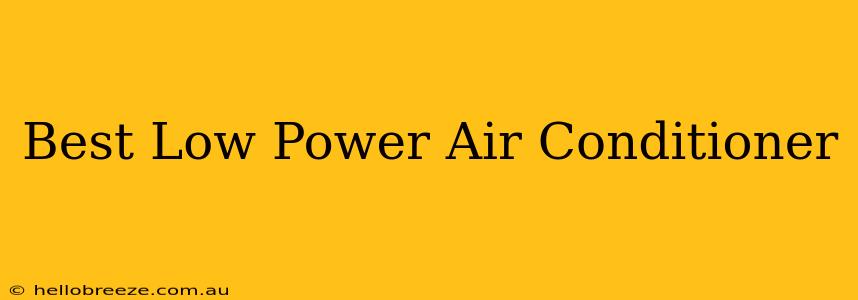Summer heat can be unbearable, but hefty electricity bills shouldn't be. This guide explores the best low power air conditioners available, helping you stay cool and comfortable without sacrificing your budget or contributing excessively to your carbon footprint. We'll delve into key features to consider, energy efficiency ratings, and popular models to help you make an informed decision.
Understanding Energy Efficiency in Air Conditioners
Before diving into specific models, it's crucial to understand how energy efficiency is measured. The Energy Efficiency Ratio (EER) and Seasonal Energy Efficiency Ratio (SEER) are key indicators.
- EER: This measures the cooling output (in BTUs) per watt of electricity consumed. A higher EER indicates greater efficiency.
- SEER: This provides a more comprehensive measure of efficiency across a cooling season, considering varying temperatures. A higher SEER rating signifies better energy savings over the long term.
Look for air conditioners with high EER and SEER ratings for optimal energy savings.
Top Features of Low Power Air Conditioners
Beyond energy efficiency ratings, several features contribute to lower energy consumption:
- Inverter Technology: Inverter AC units adjust their compressor speed based on the desired temperature, preventing energy waste associated with constantly cycling on and off.
- Smart Features: Many modern ACs offer smart features like programmable timers and Wi-Fi connectivity, allowing for optimized energy usage based on your schedule and preferences.
- Efficient Cooling Modes: Look for models with features like "eco mode" or "sleep mode" that prioritize energy savings while maintaining a comfortable environment.
- Proper Sizing: An air conditioner that's too large or too small for your space will consume more energy. Ensure you select a unit appropriately sized for the room you intend to cool.
Best Low Power Air Conditioner Models (Examples - Replace with your research)
(Note: Specific models and availability change frequently. This section provides examples. Conduct your own thorough research to find the latest models and best deals in your region.)
Example 1: [Model Name and Brand]
- Key Features: High SEER rating, inverter technology, sleep mode, compact design.
- Pros: Energy efficient, quiet operation, easy to install.
- Cons: May have a slightly higher initial cost.
Example 2: [Model Name and Brand]
- Key Features: Excellent EER, smart features (app control), energy-saving modes.
- Pros: Affordable, user-friendly, effective cooling.
- Cons: Might be slightly louder than other models.
Example 3: [Model Name and Brand]
- Key Features: Portable design, high EER, multiple fan speeds.
- Pros: Versatile, suitable for various spaces, easy to move.
- Cons: May not be as powerful as window units.
Tips for Maximizing Energy Savings
Even with the most energy-efficient air conditioner, you can further enhance your savings by:
- Regular Maintenance: Clean filters regularly to maintain optimal performance and prevent strain on the unit.
- Proper Insulation: Ensure your home is properly insulated to minimize heat gain.
- Strategic Window Coverings: Use curtains, blinds, or window film to reduce solar heat gain.
- Smart Thermostat Use: Program your thermostat to automatically adjust temperatures when you're away or asleep.
Choosing the Right Low Power Air Conditioner for You
Selecting the best low power air conditioner depends on your specific needs and budget. Consider the size of the room, your energy consumption goals, and your desired features. By carefully considering the information provided above and conducting further research, you can find an energy-efficient and affordable cooling solution that keeps you comfortable all summer long. Remember to check reviews and compare prices before making your final decision.

